Currently Empty: ₹0.00
Salabha Asana is a reverse posture to the Bhujanga Asana (Cobra Posture), which gives a backward bend to the spine. It is recomended to practice the Salabha Asana after releasing the Bhujanga Asana. Bhujanga Asana activates the upper area while Salabha Asana activates the lower waist down area of the body.
This asana gives maximum benefit and creates balance so Bhujanga Asana is followed by Salabha Asana. Since full-locust is strenuous, it is better for the beginners to practice the half-locust posture before attempting the full-locus

Full Salabha Asana
Position of readiness:
Lie face down on the floor on your stomach, hands stretched backwards close to the thighs and the legs straight.Now making fists of the hands bring them together beneath the thighs with the wrists touching.
Steps:
Inhale slowly but deeply through both the nostrils and retaining the breath make your head straight and put the chin on the floor (use a folded towel underneath the chin). Tighten both the legs and lift them up as high as you easily can. Do not bend the knees.
Stay in the same posture for 5 to 6 seconds.
Exhale and simultaneously lower the legs slowly to the floor. Do not drop the legs. By the time the legs touch the floor you should finish exhaling.
Restrictions:
Start with three rounds on the first day. Do not practice more than four rounds.
For the beginners, it is always better to practice the half-locust posture before attempting the full-locust.
Half – Salabha Asana
For the half Salabha Asana, the position, the breathing and the body conditioning are as same as the full- Salabha Asana. The only difference is that you lift one leg up at a time. Lift legs alternatively.
Benefits
It activates the kidneys, liver, pancreas, abdominal area and all the organs of the lower part of the body. It removes constipation, wind troubles, indigestion, dysentery, diarrhea, acidity and gastro- intestinal disorders.
The Salabha Asana brings flexibility to the cervical (upper back) region and strength to the lower back. Brings a rich blood supply to the spine and the whole upper area.
